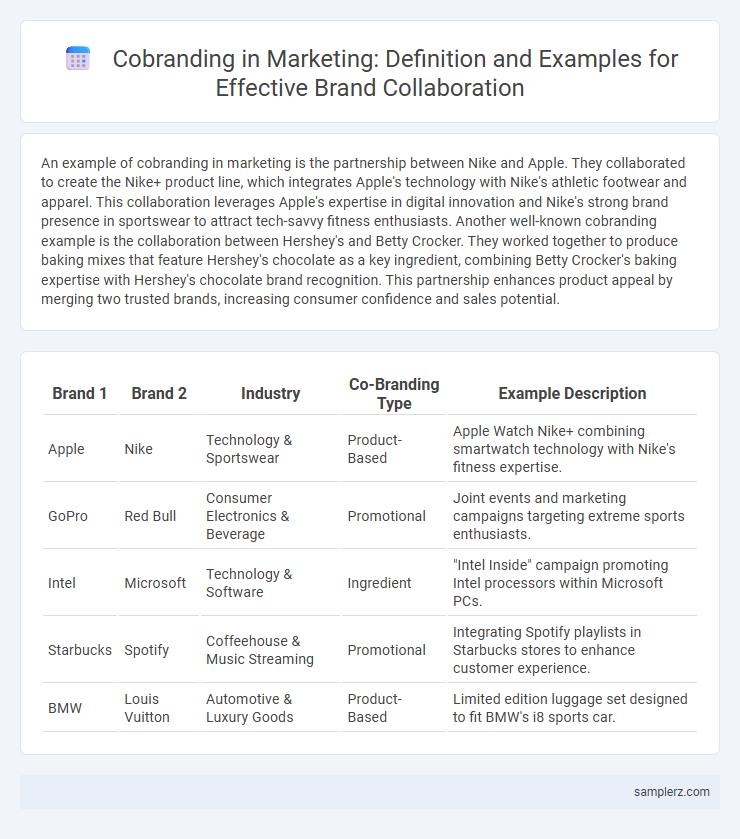An example of cobranding in marketing is the partnership between Nike and Apple. They collaborated to create the Nike+ product line, which integrates Apple's technology with Nike's athletic footwear and apparel. This collaboration leverages Apple's expertise in digital innovation and Nike's strong brand presence in sportswear to attract tech-savvy fitness enthusiasts. Another well-known cobranding example is the collaboration between Hershey's and Betty Crocker. They worked together to produce baking mixes that feature Hershey's chocolate as a key ingredient, combining Betty Crocker's baking expertise with Hershey's chocolate brand recognition. This partnership enhances product appeal by merging two trusted brands, increasing consumer confidence and sales potential.
Table of Comparison
| Brand 1 | Brand 2 | Industry | Co-Branding Type | Example Description |
|---|---|---|---|---|
| Apple | Nike | Technology & Sportswear | Product-Based | Apple Watch Nike+ combining smartwatch technology with Nike's fitness expertise. |
| GoPro | Red Bull | Consumer Electronics & Beverage | Promotional | Joint events and marketing campaigns targeting extreme sports enthusiasts. |
| Intel | Microsoft | Technology & Software | Ingredient | "Intel Inside" campaign promoting Intel processors within Microsoft PCs. |
| Starbucks | Spotify | Coffeehouse & Music Streaming | Promotional | Integrating Spotify playlists in Starbucks stores to enhance customer experience. |
| BMW | Louis Vuitton | Automotive & Luxury Goods | Product-Based | Limited edition luggage set designed to fit BMW's i8 sports car. |
Iconic Cobranding Partnerships in Marketing
Iconic cobranding partnerships like Nike and Apple revolutionize marketing by combining athletic innovation with cutting-edge technology, creating products such as the Nike+ running system that integrate fitness tracking with stylish design. Another notable example is Starbucks and Spotify, uniting global coffee culture with music streaming to enhance customer experience through curated playlists in stores. These collaborations amplify brand visibility, leverage shared audiences, and drive consumer engagement by blending complementary strengths in high-impact marketing campaigns.
Successful Cobranding Campaigns: Case Studies
Nike and Apple's collaboration on the Nike+ product line exemplifies successful cobranding, combining Nike's athletic expertise with Apple's technology to create a unique fitness experience. Another notable case is the partnership between Starbucks and Spotify, which enhanced customer engagement by integrating music streaming with the coffeehouse environment. These campaigns leveraged the strengths of both brands, resulting in increased customer loyalty and expanded market reach.
Food Industry Cobranding Examples
Food industry cobranding examples include the collaboration between Doritos and Taco Bell, which resulted in the popular Doritos Locos Tacos, blending snack and fast-food brands to create a unique product. Another instance is Starbucks partnering with PepsiCo to produce bottled coffee beverages, leveraging Starbucks' premium coffee reputation and PepsiCo's extensive distribution network. These partnerships highlight how combining brand strengths can drive innovation and expand market reach in the competitive food sector.
Cobranding in Fashion: Notable Collaborations
Cobranding in fashion leverages the strengths of two influential brands to create unique product lines that capture consumer attention, such as the collaboration between Adidas and Gucci, which blends high-performance sportswear with luxury aesthetics. The partnership between H&M and Balmain exemplifies how affordable fashion can gain prestige and exclusivity through designer influence, driving limited-edition collections with high demand. These collaborations boost brand equity, expand customer reach, and generate significant media buzz, making cobranding a strategic marketing tool in the fashion industry.
Technology Brands That Mastered Cobranding
Technology brands like Apple and Nike mastered cobranding by integrating Apple's cutting-edge wearable technology with Nike's athletic expertise, creating products such as the Apple Watch Nike+. This collaboration leverages Apple's innovation and Nike's brand loyalty to enhance user experience and expand market reach. Similarly, Microsoft and Intel partnered to optimize computing performance, coining the term "Intel Inside" to boost consumer confidence and drive sales.
Automotive Cobranding: Driving Joint Value
Automotive cobranding exemplifies strategic partnerships such as the collaboration between BMW and Louis Vuitton, where luxury design meets high-performance vehicles to attract affluent consumers seeking exclusivity. This joint value creation leverages brand equity from both automotive engineering excellence and premium lifestyle branding to enhance market positioning. Consumer engagement increases as co-branded limited editions deliver unique experiences, driving brand loyalty and boosting sales in competitive segments.
Beverage Cobranding Success Stories
Pepsi and Starbucks collaborated to create the Pepsi Starbucks Ready-to-Drink Coffee line, merging Pepsi's extensive distribution network with Starbucks' premium coffee brand to capture a growing ready-to-drink market. Another successful beverage cobranding example is the partnership between Red Bull and GoPro, leveraging Red Bull's energy drink branding with GoPro's extreme sports camera technology to engage adventure enthusiasts. These alliances boost market reach, enhance brand value, and tap into complementary customer bases within the competitive beverage industry.
Sports and Entertainment Cobranding Initiatives
Nike and Apple's collaboration on the Nike+ line seamlessly merges sportswear and technology, enhancing user experience with integrated fitness tracking. Red Bull's partnerships with extreme sports events and entertainment industries create immersive brand experiences that engage diverse audiences. The collaboration between ESPN and Disney combines sports broadcasting expertise with entertainment content, amplifying fan engagement across multiple platforms.
Digital Cobranding: Online Collaboration Examples
Digital cobranding in marketing thrives through collaborations like Spotify and Starbucks, where exclusive playlists enhance customer experience while promoting both brands simultaneously. Another notable example is Nike and Apple joining forces in the Nike+ app, integrating fitness tracking with motivational content to engage digital audiences. These partnerships leverage online platforms to create unique, shared value that boosts brand visibility and consumer interaction.
Lessons Learned from Famous Cobranding Strategies
Famous cobranding strategies like Nike and Apple's collaboration on fitness technology highlight the power of combining complementary brand strengths to create innovative products and enhance customer experience. Lessons learned emphasize the necessity of aligning brand values and target audiences to maximize mutual benefits and minimize conflicts. Successful cobranding campaigns leverage cross-industry expertise to expand market reach and build stronger brand equity through shared credibility and innovation.

example of cobranding in marketing Infographic
 samplerz.com
samplerz.com